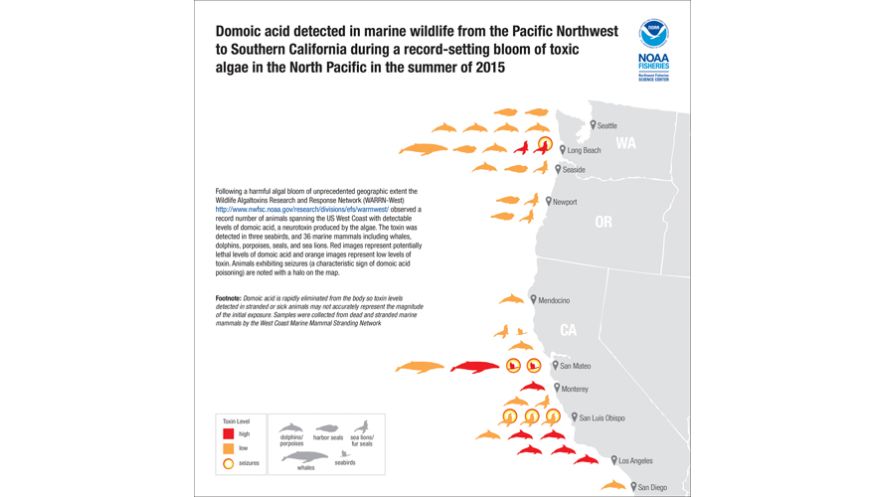Testing of samples from marine wildlife during an unprecedented harmful algal bloom on the West Coast in recent months detected domoic acid, the toxin produced by the algae, in 36 marine mammals and three seabirds collected along the coast from Southern California to the Pacific Northwest, indicating potentially widespread effects of the bloom in marine food webs.
The testing was conducted by the Wildlife Algal-toxin Research and Response Network, or WARRN-West, led by NOAA Fisheries’ Northwest Fisheries Science Center in Seattle. WARRN-West is a network of federal, state, tribal and private partners that monitors wildlife for exposure to algal toxins. NOAA’s West Coast Marine Mammal Stranding Network provided samples from stranded marine mammals as part of the monitoring effort.
The animals tested included a number of those reported to stranding networks and other authorities since the toxic bloom of Pseudo-nitzschia emerged last spring. The bloom eventually grew into the largest harmful algal bloom ever recorded on the West Coast. Tests found potentially toxic levels of domoic acid in several animals including a humpback whale and two seabirds in Northern California and sea lions in Washington. A sea lion in Washington and others in California, as well as seabirds, experienced seizures, a common sign of domoic acid poisoning.
Since the first reported poisoning of marine mammals by domoic acid in 1998 in Central California, toxic effects such as seizures and death have become common in California sea lions during blooms along the California Coast. But last May brought the first observed seizures and high concentrations of domoic acid in sea lions as far north as Washington. The findings suggest that unusually warm water off the West Coast in the past year led to a more toxic and widespread bloom with greater impacts on marine wildlife, said Kathi Lefebvre, a research biologist at the Northwest Fisheries Science Center and WARRN-West program leader.
“What is new is that we’re seeing animals with significant exposures to this toxin as far north as Washington, which is a major expansion from what we’ve seen in past events,” Lefebvre said. “The question for us is what happens next? Is this the new normal?”
Scientists emphasized that commercial seafood remains safe and state public health agencies monitor recreational fisheries for algal toxins. West Coast states restricted certain shellfish and crab fisheries in recent months after sampling identified hazardous levels of toxin. Many of those restrictions have now ended. However, the ban on razor clam harvests that began last spring in Washington remains in effect.
“Although domoic acid levels on Washington beaches have dropped significantly, they are still above the seafood safety threshold of 20 ppm,” said Dan Ayres, coastal shellfish manager for the Washington Department of Fish and Wildlife. “With the re-opening of our very popular recreational razor clam fishery delayed at least six weeks and perhaps longer, the loss of tourist-related income to Washington’s small coastal communities continues to grow.”
Testing of dead or dying wildlife during the algal bloom identified 36 marine mammals including whales, dolphins, porpoises, seals and sea lions and three seabirds with detectable levels of domoic acid. Although levels in many of the dead animals did not appear lethal, animals rapidly eliminate domoic acid from their bodies so the level identified in tests may not reflect the magnitude of the initial exposure. Researchers also noted that the animals found with domoic acid exposure may represent only a fraction of those affected, because others may not have washed ashore or been discovered.
“The toxins are commonly present in the food web but this year, with this unprecedented bloom, they’re likely having a bigger impact than ever before,” Lefebvre said. “Our concern is that there does appear to be a link between warm water and bigger blooms, so what does this tell us about future years with warmer conditions?”
Lefebvre praised the coordination and cooperation of WARRN-West partners in collecting samples and sending them to NOAA Fisheries’ Seattle laboratories for testing. The program is supported by NOAA, and many member organizations also contribute time and resources.
For more information, visit:
Watch a video of seizure observed in a sea lion near Long Beach, WA.



